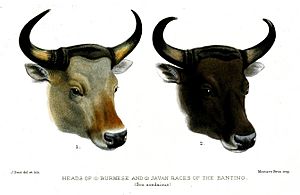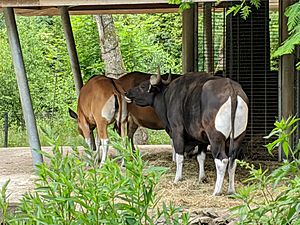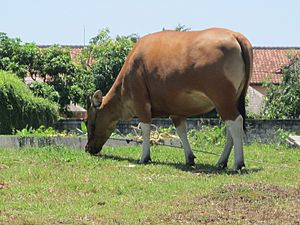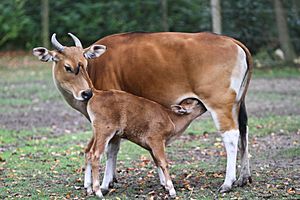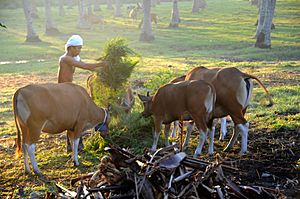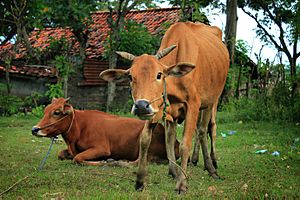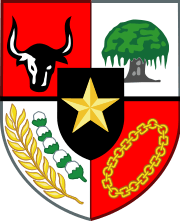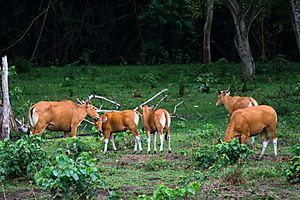Banteng facts for kids
Quick facts for kids Banteng |
|
|---|---|
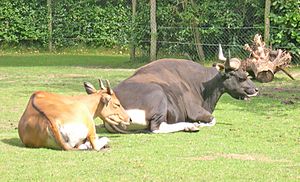 |
|
| Banteng cow (left) and bull (right) | |
| Conservation status | |
| Scientific classification | |
| Subspecies | |
|
List
Javan banteng (B. j. javanicus) d'Alton, 1823
Indochinese (or Burma) banteng (B. j. birmanicus) Lydekker, 1898 Bornean banteng (B. j. lowi) Lydekker, 1912 |
|
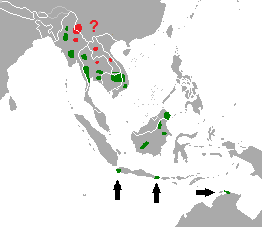 |
|
| Distribution of banteng (2010) green: present red: possibly present |
|
| Synonyms | |
The banteng (Bos javanicus), also called tembadau, is a type of wild cattle found in Southeast Asia. They are quite large, measuring between 1.9 and 3.68 m (6.2 and 12.1 ft) from head to body. Wild banteng are usually bigger and heavier than those raised by people, but they look similar. Male banteng (called bulls) are much bigger and stronger than females (cows). Bulls are often dark brown or black, while cows are thinner and usually light brown or reddish. Both have a large white patch on their rump. Both sexes have horns, which are typically 60 to 95 cm (24 to 37 in) long. There are three main types, or subspecies, of banteng.
Banteng are active both during the day and at night, especially in areas where humans are often present. They live in herds of two to forty animals, usually led by one bull. As herbivores, banteng eat plants like grasses, sedges, shoots, leaves, flowers, and fruits. They can go without water for a long time during dry periods, but they drink regularly if water is available. Banteng reproduce similar to other cattle. After being pregnant for about 285 days (nine to ten months), a cow gives birth to a single calf. Banteng live in many different places, including open deciduous forests, semi-evergreen forests, lower montane forests, old farms, and grasslands.
The biggest groups of wild banteng live in Cambodia, Java, and possibly in Borneo (especially Sabah) and Thailand. Domesticated banteng are found in Bali and many eastern Indonesian islands, Australia, Malaysia, and New Guinea. Some wild populations, called feral populations, live in East Kalimantan and the Northern Territory in Australia. People mainly raise domesticated banteng for their meat, which is very popular. They are also used to pull carts or farm equipment. Wild banteng are listed as an Endangered animal on the IUCN Red List. Their numbers have dropped by more than half in recent decades. Major threats include illegal hunting (for food, sport, traditional medicine, and horns), loss of their homes, and diseases. Banteng are protected by law in all countries where they live and are mostly found in protected areas. The banteng was the second endangered animal to be successfully cloned, and the first clone to live past being a baby.
Contents
What is a Banteng?
The banteng was first described by a German scientist named Eduard Joseph d'Alton in 1823. The name "Banteng" comes from the Javanese word for the animal. D'Alton studied two skulls from Java, Indonesia, to describe the animal.
Scientists have given the banteng other names over time, such as Bos banteng and Bos bantinger. In 1845, some scientists thought that the banteng was a type of wild ox and called it Bos sondaicus.
Different Types of Banteng
There are generally three types, or subspecies, of banteng. These types are mostly based on how they look. However, some scientists don't fully agree on these types because banteng populations often breed with other cattle. Here are the three main types:
- Javan banteng (B. j. javanicus): Found in Java and possibly Bali.
- Indochinese (or Burma) banteng (B. j. birmanicus): Lives on the mainland of Southeast Asia.
- Bornean banteng (B. j. lowi): Found only on the island of Borneo.
A study in 2015 looked at the DNA of the Bornean banteng. It found that the Bornean banteng is actually more closely related to the gaur (another type of wild cattle) than to other banteng types. This suggests that the Bornean banteng might be its own separate species.
How to Identify a Banteng
Banteng look similar to other cattle. Their head and body length is between 1.9 and 2.25 m (6.2 and 7.4 ft). Wild banteng are usually bigger and heavier than those raised by people. Wild Javan and Indochinese banteng cows are about 1.4 m (4.6 ft) tall at the shoulder, while bulls are about 1.6 m (5.2 ft) tall. Bornean banteng are the smallest type.
In the wild, cows weigh around 590–670 kg (1,300–1,480 lb), and bulls weigh about 600–800 kg (1,300–1,800 lb). The largest bulls can weigh 900 kg (2,000 lb) or more!
Banteng show clear differences between males and females:
- Bulls (males) are usually dark brown to black. They are larger and more strongly built.
- Cows (females) are thinner and typically light brown or reddish.
- Young banteng and females have a dark line running along their back.
- Some bulls might stay brown, sometimes with white spots like a deer.
- The fur of young bulls is reddish-brown and slowly turns darker as they grow. Very old bulls might turn gray.
- Their belly is white to light brown.
- Their face is lighter than the rest of their body, often whitish around the forehead and eyes.
- There is a large white patch on their rump, which helps herds stay together in the dark.
- Their legs are white below the knees.
- Bulls have a raised back because of their long thoracic vertebrae, which looks like a hump.
- Horns are usually 60 to 75 cm (24 to 30 in) long. Bulls have long, thin horns that curve upwards. Cows have shorter, tightly curved horns that point inwards.
- Their tail is 65 to 70 cm (26 to 28 in) long and ends in a black tuft of hair.
Banteng Life and Habits
Banteng are active both during the day and at night. They usually live in groups of two to forty animals, often with one main bull. Older male banteng might form smaller groups of two or three. Banteng are shy and like to keep to themselves, so it's hard to get close to them. They are very alert and easily stressed. They rest and find safety in thick forests. Banteng, especially cows and calves, can walk quickly and move easily through dense plants. The dhole (Asian wild dog) is a main predator of banteng.
Banteng use their strong sense of smell to find predators and to communicate with each other. Their hearing is also very good. They might make loud roars or bellows during the breeding season. Young calves can make soft "eng" sounds. High-pitched cries are used to warn others of danger.
What Banteng Eat
Banteng are herbivores, meaning they eat plants. Their diet includes grasses, sedges, shoots, leaves, flowers, and fruits. They often look for food at night in open areas. They take breaks of two to three hours to ruminate (chew their cud) and rest. During the rainy season, they might move to forests higher up to find food.
Studies have shown that banteng eat various plants like Mimosa pudica, Paspalum conjugatum, bamboo, and tree bark. They can survive without water for several days during droughts, but they drink regularly if possible, especially from standing water. They also visit salt licks to get enough salt. If there are no salt licks, they might even drink sea water. Banteng can drink very salty water and have been seen eating seaweed in northern Australia.
Reproduction and Family Life
Domesticated banteng can start having babies as early as 13 months old.
Banteng can breed all year round in captivity and in the wild in Myanmar. However, in some places like Thailand, mating peaks in May and June. After being pregnant for about 285 days (nine to ten months), a cow gives birth to a single calf. Male calves weigh about 16–17 kg (35–37 lb) at birth, while females weigh 14–15 kg (31–33 lb). Calves drink their mother's milk for up to 16 months.
In the wild, male banteng become ready to breed at three to four years old, and females at two to four years. Males reach their full size at five to six years, while females are fully grown by three to four years. Many calves die in their first six months, but their survival chances improve as they get bigger. Banteng can live for up to 26 years.
Where Banteng Live
Banteng live in many different places, including open deciduous forests, semi-evergreen forests, lower montane forests, old farms, and grasslands. They can be found up to 2,100 m (6,900 ft) above sea level.
The largest groups of wild banteng are found in Cambodia, Java, and possibly in Borneo (especially Sabah) and Thailand. They also live in Kalimantan (Borneo) and Myanmar. It's not certain if they are still present in Bali, Sarawak, China, Laos, and Vietnam. They are thought to be extinct in Bangladesh, Brunei, and India.
Domesticated banteng are found in Bali and many eastern Indonesian islands (like Sulawesi, Sumbawa, and Sumba), Australia, Malaysia, and New Guinea. Wild populations that escaped from domestication are found in East Kalimantan, the Northern Territory in Australia, and possibly in Enggano and Sangihe in Indonesia.
In the past, banteng were found across a much wider area in Southeast Asia, from China to Borneo and Java. Some cave art in East Kalimantan, dating back to about 10,000 BC, might show banteng. This suggests they lived in these areas a very long time ago.
Banteng and Humans
Humans have been connected to banteng for thousands of years. Old animal remains and cave art suggest this. Banteng may have been mentioned in ancient writings, like the Nagarakretagama from 1365 AD, which describes a royal hunt including banteng. In the 18th century, banteng were used as working animals to carry things like coffee plants.
Domesticated Banteng and Their Uses
Banteng were likely domesticated in Java or mainland Southeast Asia around 3,500 BC. The domesticated banteng are mostly known as Bali cattle in Indonesia. In 2016, Bali cattle made up about 25% of all cattle in Indonesia.
Domesticated banteng are calm and can handle hot, humid weather. They can also stay healthy even when eating poor quality food. People mainly raise them for their meat, which is known for being lean and soft. They are also used as working animals, though not as much as some other cattle. Banteng don't produce much milk; they only give milk for six to ten months, and the amount is small. They can also get sick from diseases like bovine malignant catarrhal fever. In 1964, a disease called "jembrana" killed many domesticated banteng in Bali.
Banteng in Australia
Domesticated banteng were first brought to Australia in 1849 by British soldiers at a place called Port Essington. Twenty animals were brought to the Northern Territory for meat. When the outpost was abandoned a year later, the banteng were set free. By the 1960s, scientists realized that about 1,500 wild banteng had grown from these animals. As of 2007, there are about 8,000–10,000 wild banteng in Australia, mostly in Garig Gunak Barlu National Park.
Australian banteng are sometimes seen as a problem animal because they can damage plants by eating too much. They can also carry diseases that can affect humans and other cattle. Because of this, banteng are sometimes shot to control their numbers in Australia. However, some people worry about this because banteng are endangered in other countries. Studies have shown that banteng might actually help by eating dry grass, which can prevent large fires in the forests.
Mixed Breeds (Hybrids)
Domesticated banteng have been bred with other types of cattle. Madura cattle, found in Java, are fertile mixed breeds of banteng and zebu. They are a small breed, used in local events like bull racing. Other mixed breeds include Donggala, Galekan, and Java Brebes (Jabres) cattle. While all mixed breeds with zebu can have babies, male mixed breeds from banteng and taurine cattle cannot. A program started in 2011 to cross-breed wild and domesticated banteng to improve the quality of the domesticated breed.
Banteng as a Symbol
The head of a banteng is one of the five symbols on the shield of Indonesia's national emblem, "Garuda Pancasila". It represents the fourth principle of Indonesia's philosophy, which is about democracy and working together. Many political parties in Indonesia have used the banteng's head as their symbol.
Threats and Protection
The wild banteng is listed as Endangered on the IUCN Red List. Its population has dropped by more than 50% in the last few decades. In 2008, scientists estimated there were only 5,000–8,000 banteng left in the world.
The biggest threats to banteng are:
- Poaching: Illegal hunting for food, sport, traditional medicine, and horns.
- Habitat Loss: Their homes are being destroyed or broken into smaller pieces.
- Disease: They can get sick from diseases.
Most banteng populations are small and separated from each other. Banteng are protected by law in all countries where they live. They mostly live in protected areas like national parks.
Surveys in Cambodia between 2009 and 2016 estimated about 4,600 banteng in certain wildlife sanctuaries. Most other populations are small and shrinking. In Thailand, only a few populations have more than 50 animals. In Java, surveys found that banteng numbers were declining in some parks due to poaching and habitat loss. In Borneo, numbers have also fallen sharply due to deforestation and human activity.
Threats to Domesticated Banteng
The banteng population in Australia started from only 20 animals. This means they have very little genetic diversity, which can make them weaker and less able to fight off diseases. Scientists hope that this Australian population, even though it's not native, could help save the endangered banteng by introducing new animals.
Another threat is when banteng breed with other types of cattle, which can affect the pureness of the banteng species. This is a concern in Sabah, where water buffaloes might breed with wild banteng. To protect the pureness of Bali cattle, the island of Bali has banned other cattle types.
Cloning Banteng
The banteng was the second endangered animal to be successfully cloned, and the first clone to live past being a baby. Scientists took DNA from skin cells of a dead male banteng and put it into eggs from domestic banteng cows. This process created embryos, which were then placed into domestic banteng cows. Two calves were born in April 2003. One of them lived for seven years at the San Diego Zoo before it died after breaking a leg.
Images for kids
See also
 In Spanish: Banteng para niños
In Spanish: Banteng para niños



